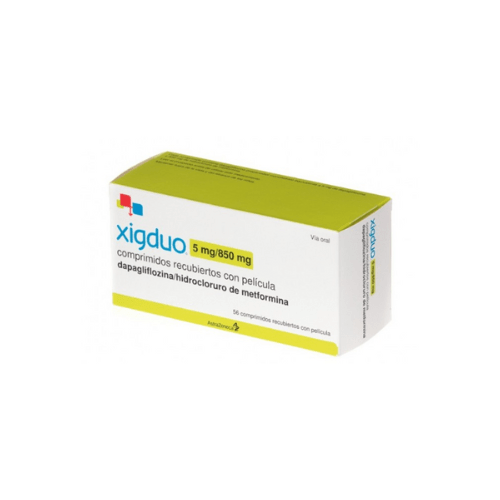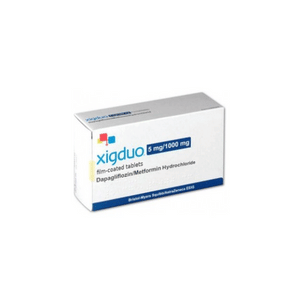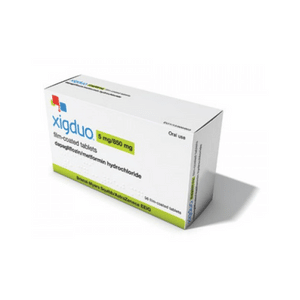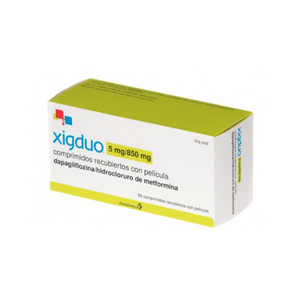Please note: a valid prescription is required for all prescription medication.
What Xigduo Is and How It Works
Xigduo combines two antidiabetic agents for adults with type 2 diabetes. It pairs dapagliflozin, a sodium-glucose cotransporter 2 (SGLT2) inhibitor, with metformin extended-release (XR), a biguanide. This page explains how the treatment works, who it suits, and how to use it safely, with US shipping from Canada for your convenience without insurance.
CanadianInsulin.com is a prescription referral platform. We verify prescriptions with your prescriber when required, and licensed Canadian pharmacies dispense your order.
Xigduo® helps lower blood glucose through two complementary mechanisms. Dapagliflozin increases urinary glucose excretion by blocking glucose reabsorption in the kidneys. Metformin XR reduces liver glucose production and improves insulin sensitivity. Together, the combination may assist with A1C reduction when used alongside diet and exercise.
This medicine is not a substitute for lifestyle measures. It is not indicated for type 1 diabetes or for diabetic ketoacidosis.
Who It’s For
Xigduo is indicated as an adjunct to diet and physical activity in adults with type 2 diabetes. It can be used when dual therapy is appropriate, such as after metformin alone is insufficient, or when starting both components is clinically suitable.
People with type 1 diabetes, those with diabetic ketoacidosis, or with severe kidney impairment should avoid this therapy. Discuss your history of kidney disease, dehydration, recurrent genital infections, or lactic acidosis with your clinician before starting. For condition background and self-management basics, review Type 2 Diabetes.
Combination agents may simplify routines by reducing pill burden. They also require careful monitoring for tolerability and kidney function.
Dosage and Usage
Xigduo is typically taken once daily with the morning meal. Swallow tablets whole; do not split, crush, or chew XR tablets. Your prescriber may adjust the dose based on current metformin tolerance, kidney function, and prior SGLT2 inhibitor exposure.
If switching from separate components, clinicians generally match the metformin XR dose and add the SGLT2 component as appropriate. Do not change your dose without consultation. Read the Patient Information for complete details, and ask how to coordinate this medicine with existing insulin or sulfonylurea therapy to reduce hypoglycemia risk.
Hydration matters. SGLT2 inhibitors can increase urination; maintain fluid intake unless advised otherwise. Rising temperatures, illness, or low-carbohydrate eating patterns may affect tolerance; contact your care team if you feel unwell.
Strengths and Forms
This medicine is supplied as extended-release tablets in multiple strength combinations. Common presentations include dapagliflozin with metformin XR in low and higher SGLT2 doses paired with metformin XR up to the typical total daily metformin limit. Availability may vary by pharmacy and region.
Refer to the package insert or your pharmacy label to confirm the exact tablet strength you receive.
Missed Dose and Timing
If you miss a dose of Xigduo, take it when you remember unless it is almost time for the next dose. If it is close to the next scheduled dose, skip the missed tablet and resume your regular schedule. Do not take two doses at once.
Taking XR tablets with food may improve gastrointestinal tolerance. Try to take it at the same time each day to support adherence.
Storage and Travel Basics
Store tablets at room temperature away from excess heat and moisture. Keep them in the original, tightly closed container and out of reach of children and pets. Do not use tablets that are damaged or expired.
For travel, carry your medication in hand luggage with a copy of your prescription. Keep the labeled bottle or a pharmacy-labeled travel pack. When crossing time zones, maintain a once-daily schedule anchored to local mornings, and bring extra tablets in case of delays.
Protect from humidity in bathrooms or gym bags. If advised to pause therapy for imaging with iodinated contrast, follow your clinician’s guidance for restart timing.
Pen Handling and Sharps Disposal
This is an oral tablet. No pens or sharps disposal steps are required.
Benefits
This treatment offers dual-mechanism glucose lowering in one daily tablet. The SGLT2 component promotes urinary glucose excretion, which may modestly reduce weight and blood pressure for some people. Metformin XR is designed to lessen stomach upset compared with immediate-release forms for many users.
Combining two agents can reduce pill counts compared with separate tablets. Streamlined routines can support adherence and consistent results. For a broader context on diabetes medicines by class, see our Diabetes Medications Guide.
Side Effects and Safety
- Gastrointestinal upset: nausea, diarrhea, or abdominal discomfort
- Urinary issues: frequent urination, urinary tract infections
- Genital yeast infections: more common in those with prior infections
- Thirst or mild dehydration: from increased urination
- Headache or dizziness: usually transient
Serious risks are uncommon but can occur. Lactic acidosis is a rare, serious metformin-related condition; seek urgent care for unexplained fatigue, muscle pain, rapid breathing, or severe stomach discomfort. SGLT2 inhibitors can, rarely, precipitate ketoacidosis even when blood glucose is not very high; seek care for nausea, vomiting, abdominal pain, or breathlessness. Severe urinary infections and a rare genital infection of the perineum have been reported. Allergic reactions can occur.
Hypoglycemia can happen when combined with insulin or a sulfonylurea. Your prescriber may adjust other agents to reduce that risk. For more background on metformin tolerability, read Metformin Side Effects.
Drug Interactions and Cautions
Tell your clinician about all medicines and supplements. Diuretics or blood pressure drugs can increase volume depletion risk. Insulin and sulfonylureas may raise hypoglycemia risk when used with this therapy. Alcohol can increase the risk of lactic acidosis; see our guidance on Alcohol and Metformin.
Temporarily discontinue before certain imaging procedures using iodinated contrast if advised. Kidney function is important for safe use; clinicians typically review eGFR before starting and periodically. Use caution if you have conditions that predispose to dehydration or low blood pressure.
Certain drugs that affect metformin elimination, such as cimetidine, may raise metformin levels; your prescriber will evaluate interactions. Report persistent genital symptoms promptly to reduce complication risk.
What to Expect Over Time
Most people can expect gradual improvement in fasting and post-meal glucose with steady daily use. Some gastrointestinal effects may appear early and often ease with continued use and food intake. Increased urination is common initially and may lessen for many users as the body adapts.
Weight and blood pressure changes vary by individual. Keep routine check-ins for labs and A1C, and bring home glucose readings to visits. If your plan includes other medicines or insulin, regular dose reviews can help maintain balance and minimize lows.
Compare With Alternatives
Other combination tablets are available if this option is not suitable. A DPP-4 inhibitor plus metformin alternative is Janumet XR. Another SGLT2 inhibitor paired with metformin is Invokamet. If monotherapy is preferred, your clinician may consider an SGLT2 agent alone such as Dapagliflozin, depending on your history and goals.
Pricing and Access
Xigduo may be more affordable through Canadian pricing with reliable US delivery. See live pricing on this page and compare options that fit your prescription. If your prescriber specifies the 5 mg/1000 mg strength, ensure your selection matches the label on your bottle.
You can check current availability and add to your cart to view options. For occasional offers, visit our Promotions page. Checkout is encrypted for your security.
Availability and Substitutions
Supply can vary. If your strength is unavailable, your prescriber may recommend a comparable alternative in the same class or separate components. Do not substitute strengths on your own.
Pharmacists can coordinate with your prescriber if a medically appropriate switch is needed. For class browsing, see Combination Tablets.
Patient Suitability and Cost-Saving Tips
This treatment may suit adults who need both SGLT2 inhibition and metformin in a single daily tablet. It may not be appropriate for those with severe kidney impairment, frequent genital infections, or a history of lactic acidosis. Those at risk of dehydration should review fluid goals.
Ask about multi-month refills to reduce per-fill fees and help maintain continuity. Set calendar reminders for renewals, and keep a small buffer so you never run out. If cost is a barrier, your prescriber may consider dose-consolidation or therapeutic alternatives within covered classes.
Questions to Ask Your Clinician
- Starting dose: how will my initial dose be chosen?
- Monitoring: how often should labs and A1C be checked?
- Other drugs: do I need changes to insulin or a sulfonylurea?
- Illness plan: when should I pause therapy if I am sick?
- Procedures: should I stop before iodinated contrast exams?
- Tolerability: what can I do if stomach upset occurs?
- Targets: what glucose goals should I track at home?
Authoritative Sources
For full prescribing information and safety details, review the FDA-approved label on DailyMed; open access information is available here: FDA DailyMed official database for drug labeling.
Manufacturer resources can offer patient leaflets and professional guidance; see AstraZeneca’s resources: AstraZeneca US medicines information page.
Regulatory listings are also available via Health Canada’s Drug Product Database for reference: Health Canada Drug Product Database search tool.
Order today from CanadianInsulin for prompt, express shipping with temperature-controlled handling when required. Medical disclaimer: This content is for informational purposes only and is not a substitute for professional medical advice.
Express Shipping - from $25.00
Shipping with this method takes 3-5 days
Prices:
- Dry-Packed Products $25.00
- Cold-Packed Products $35.00
Standard Shipping - $15.00
Shipping with this method takes 5-10 days
Prices:
- Dry-Packed Products $15.00
- Not available for Cold-Packed products
What is the difference between Xigduo XR and metformin alone?
Xigduo XR combines dapagliflozin with metformin XR for dual action. Metformin alone targets liver glucose production, while the combination also increases urinary glucose excretion.
Can I crush or split Xigduo XR tablets?
No. Extended-release tablets must be swallowed whole to maintain the release profile and reduce gastrointestinal irritation.
Does Xigduo cause hypoglycemia?
Used alone, the risk is low. When combined with insulin or a sulfonylurea, the risk increases. Your prescriber may adjust other medicines to reduce lows.
Can I drink alcohol while taking this medicine?
Alcohol can increase the risk of lactic acidosis with metformin. Limit intake and discuss safe use with your clinician, especially if you have liver or kidney concerns.
What if I am scheduled for imaging with contrast dye?
Tell your clinician and radiology team. You may be advised to pause metformin-containing therapy around iodinated contrast and restart after kidney function is reassessed.
Will I lose weight on this treatment?
Some people may experience modest weight reduction with SGLT2 inhibitors. Results vary; focus on diet, activity, and adherence for best overall control.
Is this safe with reduced kidney function?
Kidney function must be checked before and during therapy. Use is typically avoided in severe impairment; your prescriber will guide eligibility and monitoring.
Rewards Program
Earn points on birthdays, product orders, reviews, friend referrals, and more! Enjoy your medication at unparalleled discounts while reaping rewards for every step you take with us.
You can read more about rewards here.
POINT VALUE
How to earn points
- 1Create an account and start earning.
- 2Earn points every time you shop or perform certain actions.
- 3Redeem points for exclusive discounts.
You Might Also Like
Related Articles
Zepbound storage: Keep It Safe With Clear Temperature Rules
This guide explains Zepbound storage so your medication stays effective. You will learn temperature limits, how long doses can stay unrefrigerated, travel practices, and what to do if a pen…
Zepbound and Fatigue: Practical Tips to Ease Tiredness Safely
Feeling drained after starting tirzepatide can be unsettling. Many users describe a mix of low energy, mild aches, and disrupted sleep early on. If you are navigating Zepbound and fatigue,…
Mounjaro Heart Benefits Beyond Weight Loss: Evidence-Based Guide
Interest has grown around Mounjaro heart benefits as clinicians evaluate tirzepatide’s broader impact beyond glucose control and weight. Patients want clear, cautious guidance. This overview explains what current data suggests,…
Ozempic Rebound: A Practical Guide to Prevent Weight Regain
Many people stop GLP-1 therapy and wonder what comes next. Appetite changes, routine shifts, and metabolism can collide. A clear plan helps you keep progress steady and predictable, not reactive.…







